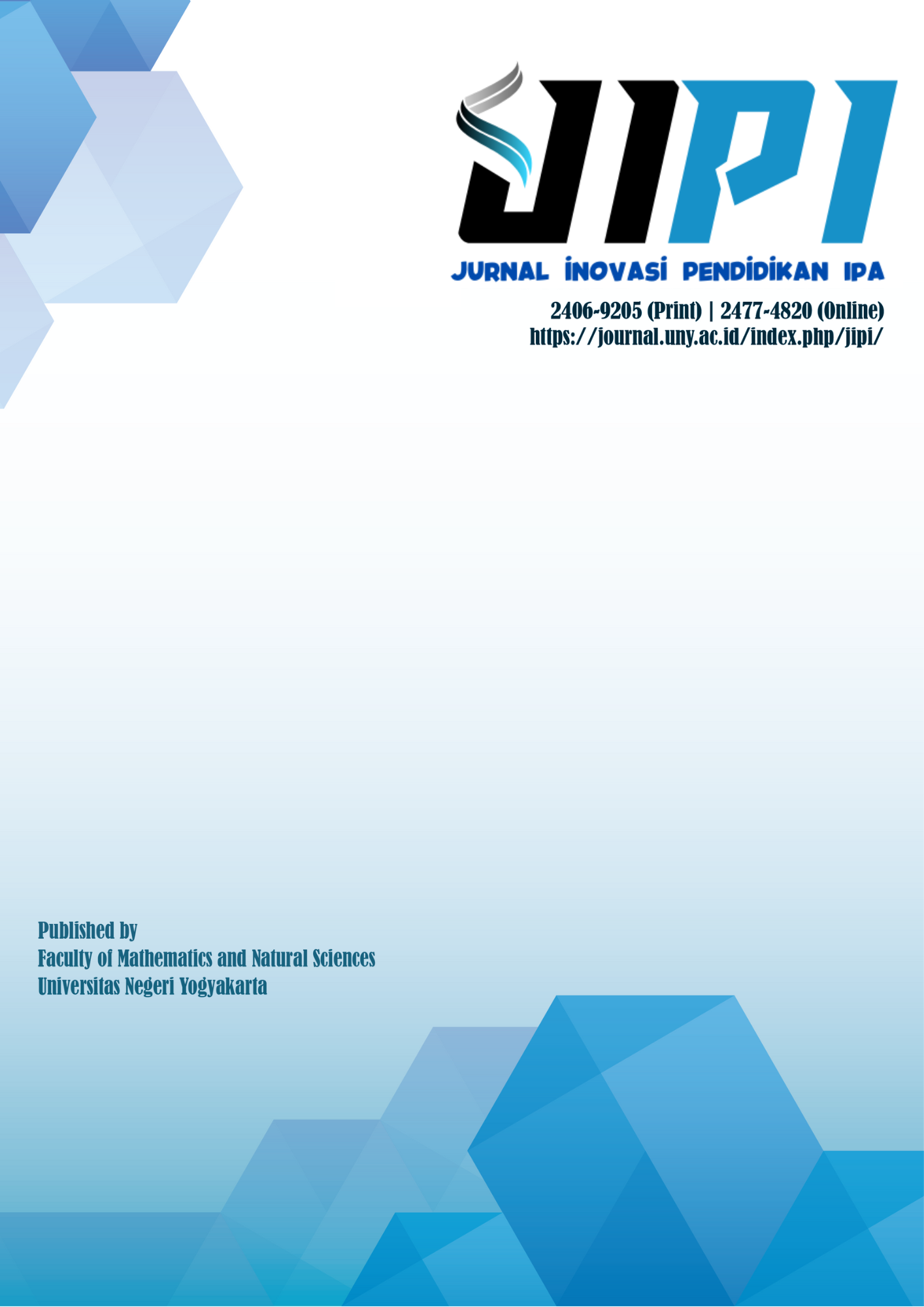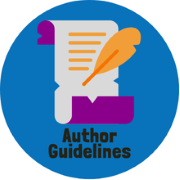Elclivs berbasis inquiry untuk meningkatkan penguasaan konsep siswa tuna netra pada materi rangkaian listrik
DOI:
https://doi.org/10.21831/jipi.v4i2.21527Keywords:
media pembelajaran, LKS taktil, rangkaian listrik, tuna netra, penguasaan konsep, tactile work sheet, instructional media, conceptual understanding, electricity circuit, visual impairmentAbstract
Tujuan penelitian ini yaitu untuk mengetahui efektivitas Elclivs berbasis Inquiry untuk meningkatkan penguasaan konsep siswa tunanetra pada materi rangkaian listrik. Metode yang digunakan dalam penelitian ini yaitu quasi experiment dengan desain one-group prettest-posttest. Partisipan yang digunakan yaitu siswa tunanetra kelas IX di SLB A Dria Adi dan SLB A YAAT. Berdasarkan hasil uji gain standar, 3 dari 5 siswa yang mengikuti pretes dan postes menunjukkan peningkatan penguasaan konsep yang baik. Hasil uji Wilcoxon menunjukkan bahwa penerapan Elclivs berbasis Inquiry belum signifikan untuk meningkatkan penguasaan konsep siswa. Perhitungan bilangan pecahan merupakan kelemahan utama siswa tunanetra dalam menguasai konsep rangkaian listrik. Namun, hasil observasi menunjukkan bahwa minat belajar, antusiame dan penalaran siswa saat mengikuti pembelajaran meningkat melalui penerapan Elclivs berbasis Inquiry. Keterampilan berhitung dalam hal ini hanya alat bantu untuk menguasai konsep. Dengan demikian hasil penelitian yang diperoleh dapat disimpulkan bahwa Elclivs dapat menigkatkan penguasaan konsep siswa pada materi rangkaian listrik.
Elclivs-inquiry based to enhance visual impairment student conceptual understanding in electricity circuit topics
Abstract
The aims of this research to know the effectiveness of Elclivs-Inquiry-based to enhance conceptual understanding on Electricity circuit topics of visual impairment student. One-group pretest-posttest quasi-experimental design was used. IX grade visual impairment students in Dria Adi and YAAT Klaten Special Education School have participated in this research. 3 of 5 students who take the pretest and posttest obtained the good level of conceptual understanding normalized gain. Wilcoxon test was showed that Elclivs-Inquiry-based implementation is not significant to enhance visual impairment student conceptual understanding. Fraction number calculations is the most visual impairment lacks to understanding the electricity circuit concept. However, the observation showed that the learning interest, enthusiasm, and reasoning of student increase by Elclivs-Inquiry-based implementation. Mathematics calculation skill is the tools to obtain the conceptual understanding. So it can conclude that Elclivs can enhance conceptual understanding of visual impairments students in electricity circuit topics.
References
Abdi, A. (2014). The effect of inquiry-based learning method on students ' academic achievement in science course, 2(1), 37–41. https://doi.org/10.13189/ujer.2014.020104
Astono, J., Rosana, D., Sumarna, S., & Maryanto, A. (2010). Pengembangan model praktikum sains untuk siswa tunanetra melalui pendekatan konstruktivis serta aplikasinya pada pendidikan inklusif. Cakrawala Pendidikan, 24(1), 43–54.
Borich, G. D. (2015). Observation skills for effective teaching: research-based practice seventh edition. London: Routledge.
Buck, L. B., Bretz, S. L., & Towns, M. H. (2008). Characterizing the level of inquiry in the undergraduate laboratory. Journal of College Science Teaching, 38(1), 52–58.
Bí¼lbí¼l, M. Åž. (2012). Blind student's experience about 3D electric circuits through Bloom's taxonomical method. In 2nd World Conference on Information Technology (WCIT-2011) Blind (Vol. 1, pp. 68–72). Ankara, Turkey: Middle East Technical University, Department of Secondary Science and Mathematics Education.
Bybee, R. W. (2009). The BSCS 5E instructional model and 21st century skills. Colorado Springs CO: BSCS.
Creswell, J. W. (2013). Research design: pendekatan kualitatif, kuantitatif, dan mixed (III). Yogyakarta: Pustaka Pelajar.
Farrand, K., Wild, T. A., & Hilson, M. P. (2016). Self-efficacy of students with visual impairments before and after participation in an inquiry-based camp. Journal of Science Education for Students with Disabilities, 19(1), 50–60.
Firdaus, M., & Wilujeng, I. (2018). Pengembangan LKPD inkuiri terbimbing untuk meningkatkan keterampilan berpikir kritis dan hasil belajar peserta didik. Jurnal Inovasi Pendidkan IPA, 4(1), 26–40. https://doi.org/http://dx.doi.org/10.21831/jipi.v4i1.5574
Fusco, G., & Morash, V. S. (2014). The Tactile Graphics Helper : Providing Audio Clarification for Tactile Graphics Using Machine Vision Categories and Subject Descriptors. Proceedings of the 17th International ACM SIGACCESS Conference on Computers & Accessibility, 491–500. https://doi.org/10.1145/2700648.2809868
Gautam, A., Bhambal, A., & Moghe, S. (2018). Effect of oral health education by audio aids, Braille & tactile models on the oral health status of visually impaired children of Bhopal city. Journal of Oral Biology and Craniofacial Research, 8(3), 168–170. https://doi.org/10.1016/j.jobcr.2017.03.002
Gupta, R., Balakrishnan, M., & Rao, P. V. M. (2017). Tactile diagrams for the visually impaired. IEEE Potentials, 36(1), 14–18. https://doi.org/10.1109/MPOT.2016.2614754
Hake, R. (1998). Interactive-engagement versus traditional methods : a six-thousand-student survey of mechanics test data for introductory physics courses. American Journal of Physics, 66(1), 64–74.
Hasper, E., Windhorst, R. A., Hedgpeth, T., Tuyl, L. Van, Gonzales, A., & Martinez, B. (2015). Courses to the visually impaired. Journal of College Science Teaching, 44(6), 82–89. https://doi.org/10.2505/4/jcst15_044_06_92
Kroes, K., Lefler, D., Schmit, A., & Supalo, C. A. (2016). Development of accessible laboratory experiments for students with visual impairments. Journal of Science Education for Students with Disabilities, 19(1), 61–67.
Majerova, H. (2016). Mentalese in persons with visual impairment from a qualitative viewpoint. Procedia-Social and Behavioral Sciences, 217, 567–575. https://doi.org/10.1016/j.sbspro.2016.02.048
NGSS Lead States. Next Generation Science Standards: For States, by States., Achieve, Inc. on behalf of the twenty-six states and partners that collaborated on the NGSS § (2013). https://doi.org/10.17226/18290
Nurwahidah, I. (2017). Penggunaan asesmen pembelajaran IPA bagi siswa visual impairment di SLB Jawa Tengah. JIPVA (Jurnal Pendidikan IPA Veteran), 1(1), 39–50.
OECD. (2009). Students with Disabilities, Learning Difficulties and Disadvantages in the Baltic States, South Eastern Europe and Malta. OECD Publication. Retrieved from www.oecd.org/publishing/corrigenda
Okcu, B., & Sí¶zbilir, M. (2017). An activity design for students with visual impairment: what is electrical fuse? Journal of Inquiry Based Activities (JIBA), 7(1), 42–50.
Rahayu, N. (2017). Pengaruh pembelajaran dengan pendekatan inquiry terhadap penguasaan konsep dan scientific skill materi sistem pencernaan. Jurnal Inovasi Pendidikan IPA, 3(1), 70–77.
Rizzo, K. L., & Taylor, J. C. (2016). Effects of inquiry-based instruction on science achievement for students with disabilities : an analysis of the literature. Journal of Science Education for Students with Disabilities, 1–16.
Rosana, D., & Sukardiyono, S. (2015). The items analysis and the identification of final test score inappropiateness to standardize the assesment. Jurnal Kependidikan, 45(2), 130–141.
Rosenblum, L. P., & Smith, D. (2012). Instruction in specialized braille codes, abacus, and tactile graphics at universities in the United States and Canada. Journal of Visual Impairment & Blindness, 106(6), 339–350.
Salleh, N. M., & Ali, M. M. (2010). Students with visual impairments and additional disabilities. Procedia-Social and Behavioral Sciences, 7(2), 714–719. https://doi.org/10.1016/j.sbspro.2010.10.097
Supalo, C. A., Kreuter, R. A., Musser, A., Han, J., Briody, E., McArtor, C., ... Mallouk, T. E. (2006). Seeing chemistry through sound: a submersible audible light sensor for observing chemical reactions for students who are blind or visually impaired. Assistive Technology Outcomes and Benefits, 3(1), 110–116. Retrieved from http://eric.ed.gov/?id=EJ902512
van den Akker, J., Bannan, B., Kelly, A. E., Nieveen, N., & Plomp, T. (2013). Educational Design Research Part (a): An introduction. Enschede: Enschede, the Netherlands: Netherlands Institute for Curriculum Development (SLO).
Widiyawati, Y. (2017). Pemanfaatan media pembelajaran IPA bagi peserta didik visual impairment di SLB. JIPVA (Jurnal Pendidikan IPA Veteran), 1(1), 9–23.
Zamfrov, M., & Saeva, S. (2012). School actvities in natural sciences for students with special needs in Bulgaria. Journal of Science Education for Students with Disabilities, 16(1), 23–33. https://doi.org/10.14448/jsesd.05.0003
Downloads
Published
How to Cite
Issue
Section
Citation Check
License
The authors submitting a manuscript to this journal agree that, if accepted for publication, copyright publishing of the submission shall be assigned to Jurnal Inovasi Pendidikan IPA (JIPI). However, even though the journal asks for a copyright transfer, the authors retain (or are granted back) significant scholarly rights.
Jurnal Inovasi Pendidikan IPA by http://journal.uny.ac.id/index.php/jipi/index is licensed under a Creative Commons Attribution-ShareAlike 4.0 International License.










